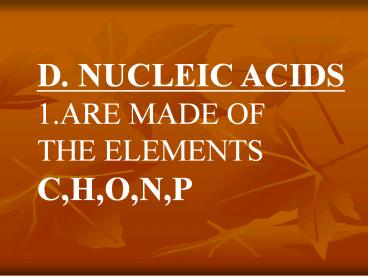D. NUCLEIC ACIDS - PowerPoint PPT Presentation
1 / 18
Title:
D. NUCLEIC ACIDS
Description:
d. nucleic acids are made of the elements c,h,o,n,p 2. include dna and rna 3. are large & complex organic molecules that: store and transmit hereditary information ... – PowerPoint PPT presentation
Number of Views:158
Avg rating:3.0/5.0
Title: D. NUCLEIC ACIDS
1
- D. NUCLEIC ACIDS
- ARE MADE OF
- THE ELEMENTS
- C,H,O,N,P
2
2. INCLUDE DNA AND RNA
3
3. ARE LARGE COMPLEX ORGANIC MOLECULES THAT
STORE AND TRANSMIT HEREDITARY INFORMATION,
CONTAIN THE CODE FOR SEQUENCING AMINO ACIDS
INTO PROTEINS
4
4. USE A SYSTEM OF 4 COMPOUNDS TO STORE
HEREDITARY INFORMATION.
5
5. THE SEQUENCE OF THE FOUR COMPOUNDS OR BASES
DETERMINES THE GENETIC CODE OF THE ORGANISM.
6
This is accomplished as follows The sequence of
bases adenine, guanine, cytosine and thymine
in the DNA Determines the sequence of amino
acids The amino acid sequence is the primary
structure of a protein Then hydrogen bonds
will determine whether the amino acid chain is a
helix or A pleated sheet this is the secondary
structure
7
Next the interactions of the R groups
hydrophobic fold in/hydrophilic out the Charge
of the R groups/ the building of disulfide
bridges cause the helix or sheet To twist and
fold this is the tertiary structure
8
These factors along with the fact that some
proteins are made of more than one Polypeptide
chain (quarternary structure) ultimately
determine the shape of the protein Structure
influences function
9
6. THE FOUR BASES ARE ADENINE THYMINE
CYTOSINE GUANINE
10
ADENINE
11
GUANINE
12
CYTOSINE
13
THYMINE
14
7. DNA STANDS FOR DEOXYRIBONUCLEIC ACID
15
8. RNA STANDS FOR RIBONUCLEIC ACID
16
9. THE MONOMERS OF NUCLEIC ACIDS ARE CALLED
NUCLEOTIDES
17
(No Transcript)
18
(No Transcript)

